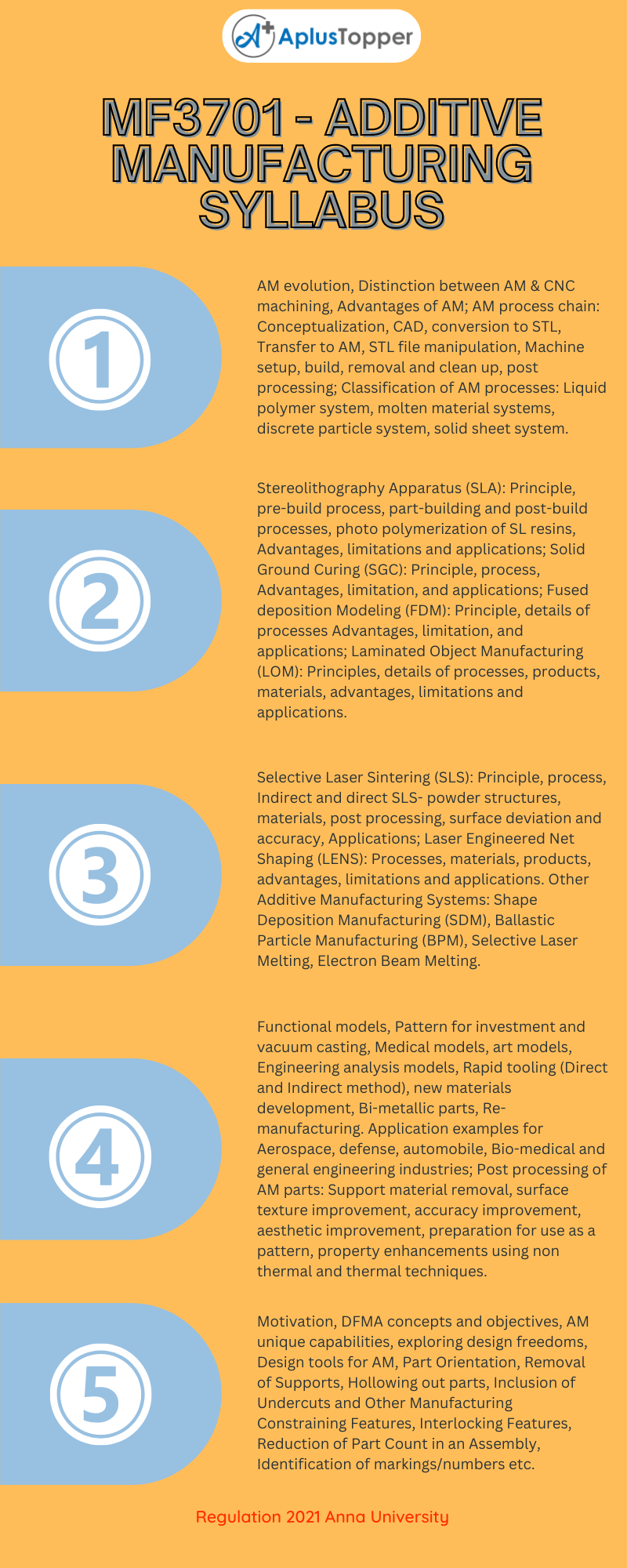This article code MF3701 explains the subject syllabus of Anna University B.E Manufacturing Engineering in the seventh semester. We aim to provide the Additive Manufacturing syllabus based on regulation 2021.
We intend to give helpful information regarding the syllabus Of Anna University B.E Manufacturing Engineering students. Subject code MF3701 – Additive Manufacturing syllabus assists the students in getting unit-wise info without leaving a topic from the syllabus. We included the required textbooks and references. The following image we added in this article will help you just by reading you will be able to get the whole syllabus of this subject. Hope you find this information useful. Never forget to share with your friends if you like this information. Comment below if you have any doubts regarding the syllabus of the subject.
If you want to know more about the syllabus of B.E. Manufacturing Engineering connected to an affiliated institution’s four-year undergraduate degree program. We provide you with a detailed Year-wise, semester-wise, and Subject-wise syllabus in the following link B.E. Manufacturing Engineering Syllabus Anna University Regulation 2021.
Aim Of Objectives:
- To introduce the development of Additive Manufacturing (AM), various business opportunities and applications
- To familiarize various software tools, processes and techniques to create physical objects that satisfy product development/prototyping requirements, using AM.
- To be acquainted with vat polymerization and material extrusion processes.
- To be familiar with powder bed fusion and direct energy deposition.
- To gain knowledge on applications of binder jetting, material jetting and laminated object manufacturing processes.
MF3701 – Additive Manufacturing Syllabus
Unit – I: Introduction
AM evolution, Distinction between AM & CNC machining, Advantages of AM; AM process chain: Conceptualization, CAD, conversion to STL, Transfer to AM, STL file manipulation, Machine setup, build, removal and clean up, post-processing; Classification of AM processes: Liquid polymer system, molten material systems, discrete particle system, solid sheet system.
Unit – II: Liquid And Solid Based Am Process
Stereolithography Apparatus (SLA): Principle, pre-build process, part-building and post-build processes, photopolymerization of SL resins, Advantages, limitations and applications; Solid Ground Curing (SGC): Principle, Process, Advantages, limitation, and applications; Fused deposition Modeling (FDM): Principle, details of processes Advantages, limitation, and applications; Laminated Object Manufacturing (LOM): Principles, details of processes, products, materials, advantages, limitations and applications.

Unit – III: Powder Based Am Process
Selective Laser Sintering (SLS): Principle, process, Indirect and direct SLS- powder structures, materials, post-processing, surface deviation and accuracy, Applications; Laser Engineered Net Shaping (LENS): Processes, materials, products, advantages, limitations and applications. Other Additive Manufacturing Systems: Shape Deposition Manufacturing (SDM), Ballastic Particle Manufacturing (BPM), Selective Laser Melting, Electron Beam Melting.
Unit – IV: Am Applications
Functional models, Pattern for investment and vacuum casting, Medical models, art models, Engineering analysis models, Rapid tooling (Direct and Indirect method), new materials development, Bi-metallic parts, and Re-manufacturing. Application examples for Aerospace, defense, automobile, Bio-medical and general engineering industries; Post-processing of AM parts: Support material removal, surface texture improvement, accuracy improvement, aesthetic improvement, preparation for use as a pattern, property enhancements using nonthermal and thermal techniques.
Unit – V: Design For Am
Motivation, DFMA concepts and objectives, AM unique capabilities, exploring design freedoms, Design tools for AM, Part Orientation, Removal of Supports, Hollowing out parts, Inclusion of Undercuts and Other Manufacturing Constraining Features, Interlocking Features, Reduction of Part Count in an Assembly, Identification of markings/ numbers etc.
Text Books:
- Andreas Gebhardt and Jan-Steffen Hötter “Additive Manufacturing: 3D Printing for Prototyping and Manufacturing”, Hanser publications, United States, 2015, ISBN: 978- 1 -56990-582-1.
- Ian Gibson, David W. Rosen and Brent Stucker “Additive Manufacturing Technologies: RapidPrototyping to Direct Digital Manufacturing”, 2nd edition, Springer., United States, 2015, ISBN13: 978-1493921126.
References:
- Amit Bandyopadhyay and Susmita Bose, “Additive Manufacturing”, 1st Edition, CRC Press., United States, 2015, ISBN-13: 978-1482223590.
- Andreas Gebhardt, “Understanding Additive Manufacturing: Rapid Prototyping, Rapid Manufacturing”, Hanser Gardner Publication, Cincinnati., Ohio, 2011, ISBN:9783446425521.
- Kamrani A.K. and Nasr E.A., “Rapid Prototyping: Theory and Practice”, Springer., United States, 2006, ISBN: 978-1 -4614-9842-1.
- Liou, L.W. and Liou, F.W., “Rapid Prototyping and Engineering Applications: A toolbox for prototype development”, CRC Press., United States, 2011, ISBN: 9780849334092.
- Milan Brandt, “Laser Additive Manufacturing: Materials, Design, Technologies, and Applications”, Woodhead Publishing., United Kingdom, 2016, ISBN: 9780081004333.
Related Posts On Semester – VII:
Must Read:
